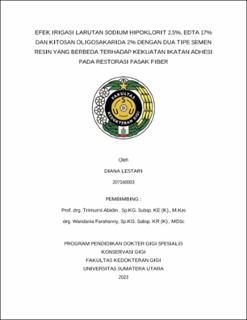Efek Irigasi Larutan Sodium Hipoklorit 2,5%, EDTA 17% dan Kitosan Oligosakarida 2% dengan Dua Tipe Semen Resin yang Berbeda terhadap Kekuatan Ikatan Adhesi pada Restorasi Pasak Fiber
Irrigation Effect of 2.5% Sodium Hypochlorite Solution, 17% EDTA and 2% Chitosan Oligosaccharide with Two Different Types of Resin Cement on Adhesion Bond Strength in Fiber Post Restorations

Date
2023Author
Lestari, Diana
Advisor(s)
Abidin, Trimurni
Farahanny, Wandania
Metadata
Show full item recordAbstract
Introduction: The achievement of strong adhesion between fiber pegs, dentin, and adhesive resin cement poses a persistent issue primarily attributed to the insufficient removal of the smear layer. Multiple investigations have demonstrated that the utilization of a sodium hypochlorite (NaOCl) irrigation solution in conjunction with ethylenediaminetetraacetic acid (EDTA) leads to a reduction in the adhesive binding strength between the peg and dentin. According to available reports, chitosan oligosaccharide at a concentration of 2% has been identified as a potential biocompatible irrigation agent. The objective of this research was to investigate the impact of a 2% chitosan (COS) alternative irrigation material on the adhesive bond strength of peg restorations.
Materials and Methods: A total of thirty mandibular premolars with certain inclusion criteria were selected for the study. These teeth underwent decontamination at the cementoenamel junction (CEJ) and were afterwards treated and prepared for post space therapy. The teeth were categorized into six distinct groups, denoted as A1 (involving irrigation with a 2.5% sodium hypochlorite (NaOCl) solution and 17% ethylenediaminetetraacetic acid (EDTA)), A2 (involving irrigation with a 2.5% NaOCl solution containing 2% chlorhexidine digluconate (COS)), A3 (involving irrigation with a 2% COS solution), B1 (involving irrigation with a 2.5% NaOCl solution and 17% EDTA), B2 (involving irrigation with a 2.5% NaOCl solution containing 2% COS), and B3 (involving irrigation with a 2% COS solution). Subsequently, groups A1, A2, and A3 were affixed utilizing self-adhesive resin cement, whereas groups B1, B2, and B3 employed the total-etch technique. The entire tooth specimen was divided into three segments, following which a push-out test was conducted utilizing a Universal Testing Machine (UTM) apparatus. The collected data underwent a One-way ANOVA statistical analysis, and subsequent observations were conducted utilizing a stereomicroscope.
Results: The findings of the one-way ANOVA test indicated a statistically significant disparity in the adhesion bond strength between resin cement and root canal dentin across all treatment groups (p<0.05).
Conclusion: The application of a 2% oligosaccharide chitosan solution during the preparation of the peg space resulted in a notable enhancement in the adhesive properties of both total-etch resin cement and self-adhesive resin cement.
Collections
- Master Theses [69]
